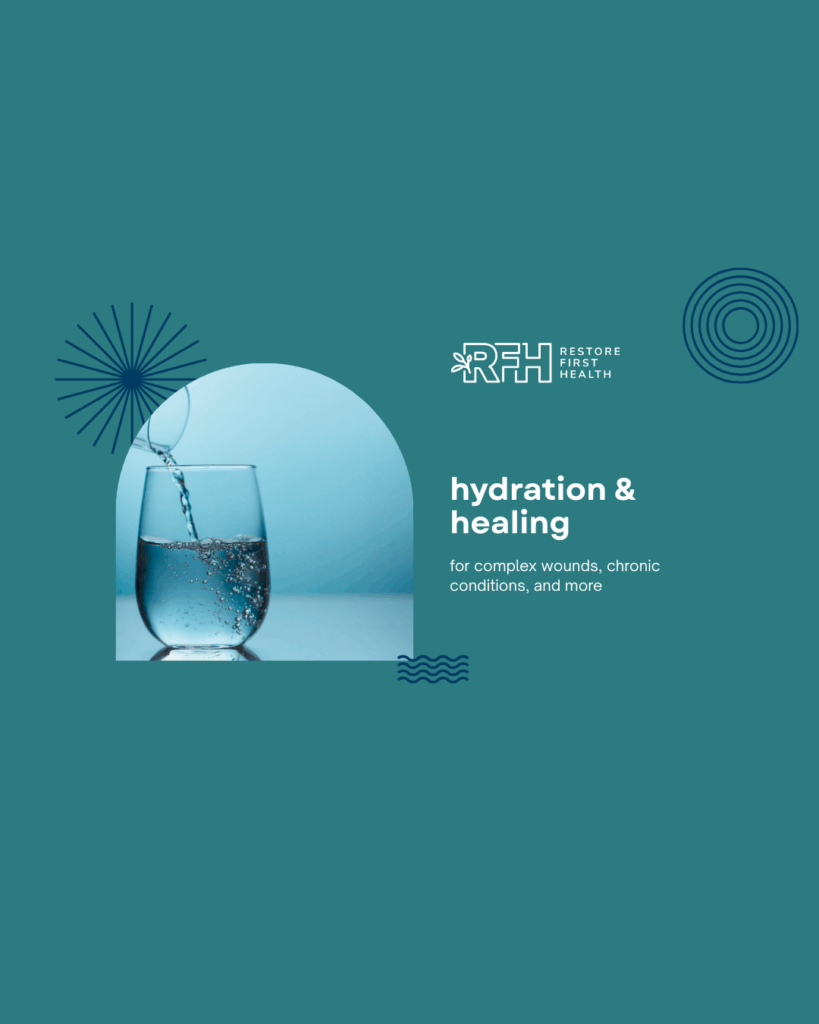When someone is living with leg swelling or struggling with an open skin wound, hydration is often the last thing they think about. Yet research shows that hydration is one of the most important and overlooked factors in wound healing. For patients with complex wounds, proper hydration supports circulation, reduces inflammation, and helps the body repair damaged tissue.
Hydration and its role in wound healing
Water plays a role in nearly every step of wound repair. Studies confirm that wounds heal more quickly in a moist environment because cells can move across the wound bed more easily, growth factors are preserved, and tissue breakdown is reduced (Ousey et al., 2016; Tan, 2019). Dehydration, on the other hand, leaves skin dry and fragile, which increases the risk of wound breakdown and infection.
Hydration also supports immune function. Poor fluid balance can delay the arrival of immune cells needed to fight bacteria. Chronic wounds such as diabetic foot ulcers often show slower healing when skin hydration is below a certain threshold (Lee et al., 2022).
At Restore First Health, collaboration and education is a priority, every time.
To learn more about how we could support you in partnership, tap here
The connection between leg swelling and wounds
Leg swelling, also known as edema, creates an environment that makes wound healing more difficult. When fluid builds up in the legs, blood flow to the skin decreases, oxygen delivery is limited, and tissues become more vulnerable to breakdown. A large study found that people with chronic leg swelling had significantly higher rates of non-healing wounds compared to those without swelling (Burian et al., 2021).
The good news is that reducing edema can dramatically improve healing. One clinical trial showed that aggressive edema reduction in patients with diabetic foot wounds improved healing rates and lowered complications (Armstrong et al., 2000). This means hydration strategies must be carefully balanced with swelling management, often using elevation and compression therapy under the guidance of a care team.
Practical hydration tips for patients and caregivers

- Sip water steadily throughout the day rather than drinking large amounts all at once.
- Watch for pale yellow urine as a simple sign of adequate hydration.
- Pair hydration with a low-sodium diet when swelling is present.
- Include hydrating foods such as fruits, soups, and vegetables.
- Report sudden changes such as rapid swelling or decreased urination to your healthcare provider.
Remember…
Hydration alone will not heal a complex or open wound, but it creates the conditions for the body to repair itself. For people dealing with leg swelling, complex wounds, or openskin wounds, consistent hydration combined with expert wound care can make the difference between a wound that lingers and a wound that heals.
References
- Armstrong DG, Nguyen HC, Lavery LA, van Schie CH, Boulton AJ, Harkless LB. Improvement in healing with aggressive edema reduction in diabetic foot wounds. Arch Surg. 2000;135(11):1405-1409. JAMA Network
- Burian EA, Färkkilä N, Bergan JJ, Partsch H, Cornu-Thenard A, Foldi E, et al. Wounds in chronic leg oedema. Int Wound J. 2021;18(1):13-22. PMC
- Cullen B, Smith R, McCulloch E, Silcock D, Morrison L. The biological and physiological impact of chronic wound fluid composition. Front Immunol. 2022;13:980421. PMC
- Lee TY, Hsieh SH, Hung YJ, et al. Skin hydration level cutoff value to predict wound healing of diabetic foot ulcers. Diabetes Res Clin Pract. 2022;188:109901. ScienceDirect
- Ousey K, Cutting KF, Rogers AA, Rippon MG. The importance of hydration in wound healing: reinvigorating the clinical perspective. J Wound Care. 2016;25(3):122-130. PubMed
- Tan ST. The reason behind moist wound environment. Open Dermatology Journal. 2019;13:34-40. Open Dermatology Journal
